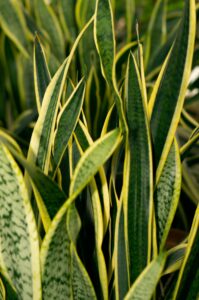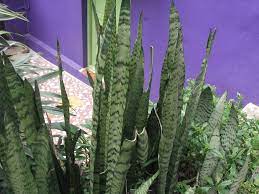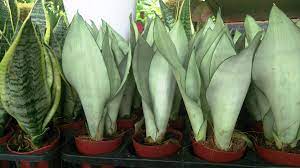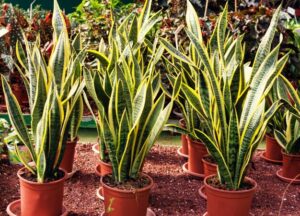
Welcome to “The Trusted House Plant Guide,” where we strive to offer invaluable  insights and guidance for fostering the healthiest home and growing environments. Today, we turn our focus to a remarkably resilient and popular member of the indoor plant world: the Snake Plant or Dracaena trifasciata. Known for its striking appearance and minimal care requirements, the snake plant has carved a niche in the hearts of plant enthusiasts and beginners alike.
insights and guidance for fostering the healthiest home and growing environments. Today, we turn our focus to a remarkably resilient and popular member of the indoor plant world: the Snake Plant or Dracaena trifasciata. Known for its striking appearance and minimal care requirements, the snake plant has carved a niche in the hearts of plant enthusiasts and beginners alike.
In this comprehensive guide, we aim to unveil every aspect of these fascinating plants. From the diverse varieties that grace homes worldwide to the remarkable benefits they offer, and finally, to the simple yet effective care techniques, we have it all covered. Whether you’re looking to add a new member to your plant family or seeking to deepen your knowledge about these green companions, you’re in the right place. So, let’s embark on this green journey and unlock the secrets of snake plants.
Part 1: The World of Snake Plants or Dracaena trifasciata
Snake plants, a name that evokes images of serpentine foliage, are more than just an aesthetic addition to your home. Let’s delve into the history and explore the various types of snake plants that you might encounter.
A Brief History and Origin
The snake plant, originally found in tropical West Africa, has a long history intertwined with folklore and practical use. In Africa, it was revered not only for its unique appearance but also for its supposed spiritual and protective qualities. This plant has journeyed from the dense tropical forests to the hearts of plant lovers around the globe, becoming a staple in homes and offices.
Understanding Snake Plant Varieties
There is a surprising diversity among snake plants, each variety boasting its unique charm. The most well-known is perhaps the Sansevieria Laurentii, a striking variety with its green center and bright yellow margins. It’s not just a visual delight but also one of the most robust types, thriving in a range of conditions.
its unique charm. The most well-known is perhaps the Sansevieria Laurentii, a striking variety with its green center and bright yellow margins. It’s not just a visual delight but also one of the most robust types, thriving in a range of conditions.
Next, the Golden Hahnii, a compact variety, offers a more subdued elegance with its shorter leaves and yellow-bordered rosettes. Ideal for smaller spaces, it brings the same air-purifying qualities as its larger counterparts.
For those who prefer a subtler look, the Silver Hahnii presents itself as an excellent choice. Its pale green leaves, edged with darker green, form a beautiful contrast, making it a sophisticated addition to any indoor garden.
These types of snake plants not only differ in appearance but also in their adaptability to different environments. Some thrive in brighter light, while others are more tolerant of low light conditions, offering a variety for every type of plant parent.
Part 2: Snake Plant Types and Key Factors in choosing
In this section, we’ve started to explore the rich history and diversity of snake plants, setting the stage for further discussion on their benefits and care in the upcoming sections. Stay tuned as we continue to delve deeper into the world of these remarkable plants.
| Common Name | Scientific Name | Key Feature | Best Growing Environment | Ease of Care |
| Golden Hahnii | Sansevieria trifasciata ‘Golden Hahnii’ | Compact with yellow edges | Bright, indirect light; tolerates low light | Very Easy |
| Laurentii | Sansevieria trifasciata ‘Laurentii’ | Yellow-edged leaves | Bright to moderate light; adaptable to low light | Very Easy |
| Zeylanica | Sansevieria zeylanica | Robust, dark green leaves | Adaptable to most light conditions; prefers indirect light | Easy |
| Cylindrica | Sansevieria cylindrica | Tubular, round leaves | Bright, indirect light; can tolerate direct light | Moderate |
| Moonshine | Sansevieria trifasciata ‘Moonshine’ | Silvery-green foliage | Thrives in bright, indirect light; can adapt to low light | Moderate |


This list covers a range of snake plant varieties, highlighting their distinctive features, preferred growing conditions, and ease of care. The order reflects the general ease of care, with “Very Easy” varieties being the most forgiving and suitable for beginners, while “Moderate” care plants may require a bit more attention or specific conditions.
Part 3: Unveiling the Benefits
When it comes to indoor plants, the snake plant stands out not just for its striking appearance but also for its multitude of benefits. These benefits make it a valuable addition to any home or office. Let’s explore the key benefits of snake plants and understand why they are such a popular choice among plant enthusiasts.
Air Purification and Health Benefits
One of the most notable benefits of snake plants is their remarkable air-purifying ability. Renowned for their efficiency in removing harmful toxins like benzene, formaldehyde, and xylene from the air, snake plants significantly improve indoor air quality. This feature is particularly beneficial for those living in urban areas with limited ventilation.
Furthermore, unlike many plants, snake plants continue to produce oxygen even at night, making them an excellent choice for bedrooms to ensure better air quality while you sleep.
Aesthetic Appeal and Feng Shui
Beyond their health benefits, snake plants add an element of aesthetic appeal to any space. Their tall, upright leaves bring a unique architectural element, enhancing the overall decor. In Feng Shui, snake plants are believed to bring positive energy into a home, promoting a sense of well-being and harmony.
What are Snake Plants Good For?
In addition to their aesthetic and health benefits, snake plants are incredibly resilient and adaptable, making them suitable for a variety of indoor environments. Their ability to thrive in low light conditions and withstand irregular watering schedules makes them a perfect choice for both seasoned plant enthusiasts and beginners.
Following this exploration of the benefits of snake plants, our next section will delve into the essential care tips for maintaining the health and vitality of these remarkable plants. Additionally, to enhance your experience and success in growing snake plants and other houseplants, we will introduce a valuable toolbox – a list of essential tools and accessories that are key to creating a healthy growing environment. Stay tuned for this vital information that will equip you with everything you need for effective plant care.
Part 4: Essential Care Guide for Snake Plants
Now that we’ve explored the numerous benefits of snake plants, let’s delve into the crucial aspect of their care. Despite their hardiness and low maintenance nature, understanding the right care techniques will ensure your snake plants thrive and continue to beautify your space. Here’s your comprehensive guide to snake plant care.
Watering Guidelines
Snake plants prefer to be on the drier side, making overwatering one of the biggest mistakes to avoid. The key is to allow the soil to completely dry out between waterings. During the growing season (spring and summer), water them every 2-3 weeks, depending on the humidity and temperature of your home. In the winter, reduce watering to once a month or less. Employing a moisture meter can help you gauge the right time to water.
Light and Placement Requirements
While snake plants are tolerant of a wide range of light conditions, they do best in bright, indirect light. They can adapt to low light areas, but their growth might be slower. Avoid placing them in direct sunlight as it can scorch their leaves. A spot near a north or east-facing window is ideal.
Soil and Fertilization
Use a well-draining potting mix, preferably one formulated for cacti and succulents, as this will prevent water retention and root rot. Fertilize your snake plant with a general-purpose houseplant fertilizer, but only sparingly. Over-fertilization can harm these plants. Feeding them once in the spring and again in the summer is sufficient.
Pruning and General Care
Pruning is not frequently required for snake plants, but it can be useful for removing any brown or damaged tips. Use clean, sharp pruning shears for this task. To keep the leaves shiny and dust-free, gently wipe them with a damp cloth or use leaf shine products sparingly.
With these care tips in hand, your snake plants are sure to flourish. But that’s not all. In the following section, we will present a valuable toolbox for your healthy growing environment, featuring essential tools and accessories for snake plant care and beyond. This collection of tools will further aid you in maintaining the health and beauty of your snake plants and other houseplants, ensuring a thriving indoor garden.
-
Watering Can with a Long Spout: This is crucial for controlled and precise watering, ensuring that you can reach the soil directly without wetting the leaves. A long spout is especially useful for plants like snake plants that prefer water at their base.
-
Moisture Meter: Overwatering is a common issue in plant care. A moisture meter helps you determine when your plants actually need water, taking the guesswork out of the process.
-
Pruning Shears: Sharp, clean pruning shears are essential for trimming dead or overgrown foliage. This is important for the health and aesthetic of your plants.
-
Neem Oil or Insecticidal Soap: These are natural options for dealing with pests. They are effective against common houseplant pests and are safe to use indoors.
-
Leaf Shine or Soft Cloth: For plants with broad leaves like the snake plant, a leaf shine or a soft cloth can be used to gently wipe down the leaves, removing dust and keeping them glossy.
-
High-Quality Potting Mix: Specific to each plant’s needs, a high-quality potting mix ensures proper drainage and nutrient balance. For snake plants, a well-draining mix like cactus or succulent soil is ideal.
-
Fertilizer: A balanced, water-soluble fertilizer is suitable for most houseplants, including snake plants. However, fertilization should be minimal as snake plants are not heavy feeders.
-
Pots with Drainage Holes: Good drainage is vital to prevent root rot. Ensure all your pots have drainage holes and saucers to catch excess water.
-
Gloves: To keep your hands clean and protected during potting and pruning activities.
-
Support Stakes or Trellis (if needed): For climbing or vining houseplants, having support stakes or a trellis can help manage their growth and provide necessary support.
-
Spray Bottle: For plants that benefit from humidity, a fine mist spray bottle can be used to gently spritz the leaves.
-
Soil pH Meter: Some plants are sensitive to soil pH. A pH meter can help you maintain the optimal soil conditions for each plant.
We have included the above list a necessary part of your indoor plant toolkit. We use these products regularly and many more in our shop. The list does include products linked to affiliate offers that we earn a small commision but are offered to you at the same low price if not lower than you would find on your own. We thank everyone who allows us to serve with our years of experience and thank you for all the support you show us.
THATS A WRAP:
As we wrap up our journey through the fascinating world of snake plants, we hope this guide has illuminated the many facets of these versatile and resilient houseplants. From their air-purifying benefits to their ease of care, snake plants truly are a wonder of the plant world.
We at Trusted House Plant Guide are thrilled to have shared this knowledge with you. Our goal is always to provide you with the most reliable and insightful information to help you create and maintain your own healthy and vibrant indoor garden. A big thank you for visiting our site and diving into the world of snake plants with us!
But the learning doesn’t stop here! Stay tuned to TrustedHousePlantGuide.com for more tips, tricks, and educational content. We’re constantly updating our site with fresh and useful information to guide you on your plant care journey. Whether you’re a seasoned green thumb or just starting out, we have something for everyone.
So, keep visiting, keep exploring, and let’s grow together in our knowledge and love for houseplants. Remember, every plant tells a story, and we’re here to help you read it!
Happy planting and see you soon at TrustedHousePlantGuide.com!
Thank you once again for allowing us to be a part of your plant care journey. We can’t wait to share more with you in the future!
If you enjoy this content and would like to see Michelle offer a wide variety of tips tricks and ideas in another format Visit her at our YouTube Channel




Pingback: Living with Plants: Why Houseplants are Good for You - Trusted House Plant Guide
Pingback: Plant Decor: Picking a Proven Winner - The Blue Star Fern - Trusted House Plant Guide
Pingback: Snake Plant, The Ultimate Low-Maintenance Houseplant for Beginners